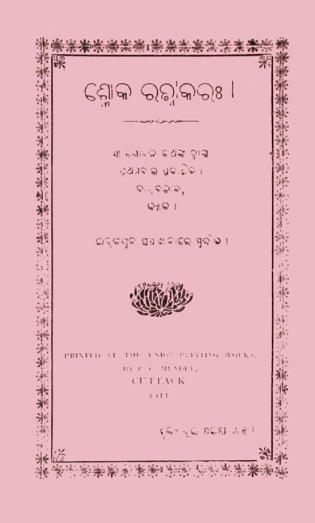In the expansive realm of Odia literature and education, the year 1913 witnessed the emergence of a significant work that continues to illuminate the path of learning: Shloka Ratnakarah, authored by the esteemed scholar and poet. This text, meaning The Treasury of Verses, serves as an essential resource for general knowledge, blending poetic form with educational content in a manner that remains both engaging and informative.
Shloka Ratnakarah stands out as a pioneering effort in the codification of knowledge within the Odia language, particularly in its use of shlokas, or verses, as a means of conveying complex information. The book encompasses a wide array of subjects, including history, geography, philosophy, science, and cultural traditions, all presented in a lyrical format that enhances memorability and comprehension. This innovative approach reflects the author’s understanding of the educational needs of his time, serving not only as a reference but also as a tool for self-study.
One of the remarkable aspects of Shloka Ratnakarah is its accessibility. The author employs clear and concise language, making intricate topics understandable to readers of varying ages and backgrounds. This focus on clarity is particularly important in a time when formal education was evolving in India, and resources were limited. By making knowledge approachable, the text encourages curiosity and fosters a love for learning, aiming to inspire a new generation of thinkers and scholars.
The use of shlokas in the book also highlights the rich poetic heritage of the Odia language. By incorporating rhythmic and structured verses, Shloka Ratnakarah not only aids in the retention of information but also celebrates the artistic beauty of language. This combination of educational content with literary finesse elevates the reading experience, providing an aesthetic pleasure alongside intellectual enrichment. Readers find themselves immersed in a world where knowledge and creativity coexist harmoniously.
Furthermore, Shloka Ratnakarah serves as a cultural artifact, reflecting the values, beliefs, and historical context of Odisha during the early 20th century. The text includes references to local legends, folklore, and historical figures, reinforcing a sense of identity and pride among Odia speakers. Through this lens, the book not only imparts general knowledge but also acts as a bridge connecting contemporary readers with their rich heritage.
The emphasis on varied subjects within Shloka Ratnakarah further underscores its significance as a general knowledge resource. By covering diverse areas of inquiry, the book encourages interdisciplinary learning and critical thinking. It fosters a holistic understanding of the world, pushing readers to make connections between different fields of knowledge. This approach is especially relevant in today’s educational landscape, where the ability to synthesize information across disciplines is increasingly valued.
As we reflect on the impact of Shloka Ratnakarah, it becomes evident that its legacy extends beyond its pages. The book has inspired educators, students, and scholars alike, contributing to the growth of knowledge in Odisha and promoting the use of the Odia language as a medium of education. Its continued relevance in contemporary discussions on general knowledge and education underscores the timeless nature of its teachings.
Books Info
| Books name | Shloka Ratnakarah / ଶ୍ଳୋକ ରତ୍ନାକରଃ |
| Author | NA |
| No Of pages | 14 |
| Publisher | NA |
| Publication | 1911 |
| Printed At | NA |
| Distributor | NA |

